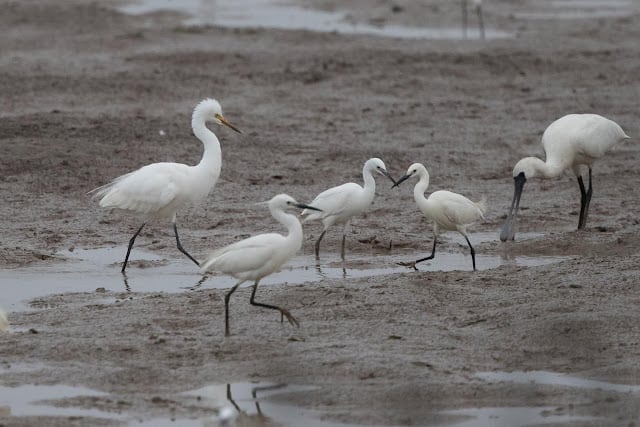Today was our only scheduled attempt for Chinese Crested Tern on Shanyutan Island to the north or Changle. Chinese Crested Tern is thought to have a total population of fewer than 100 birds. For many years it was only known from a few specimens collected prior to 1937, and a small number of, mainly unconfirmed, records from China, Thailand and Indonesia. However, in the Summer of 2000 eight adults and four chicks were found within a Greater Crested Tern colony on Matsu Island, Taiwan, and subsequently the species has been found breeding in very small numbers on Jiushan Island and Wuzhishan Island, Zhejiang province, China. Since its rediscovery this is a species I have wanted to see and so today there was much to play for.
We were up a little earlier than accustomed and driving through the streets of Changle to meet our boatman at 06:00. We than headed through Changle and parked before walking through the shrimp pools and arable land towards the island that I had last birded on 17th November 2016. During the walk to the boat we recorded Yellow-bellied Prinia, Eastern Yellow Wagtail of the subspecies tavania, Wood Sandpiper, seven Long-toed Stint, Oriental Reed-warbler, 17 Chinese Egret, 40 Black-faced Spoonbill, Chinese Pond Heron and Spotted Redshank. The ‘boat trip’ lasted around two minutes as the boat man took us across a narrow reed lined channel of no more than ten metres – a bit of an anticlimax after donning brand new life-jackets and supposedly paying $100.
We arrived on the island a couple of hours before high tide and spent our time sifting through the large wader roost and scanning to sea. Species present included Swinhoe’s (White-faced) Plover, Kentish Plover, Greater Sandplover, Lesser Sandplover, Curlew Sandpiper, Sharp-tailed Sandpiper, Red-necked Stint and large numbers of Dunlin and Sanderling. Oher species included Greater Crested Tern, Whiskered Tern, Common Tern, Caspian Tern, Gull-billed Tern, Band-tailed Gull, Arctic Herring (Mongolian) Gull and Osprey.
As the tide began to fall once again the waders began to spread out over the mudflats and Tang-Jun indicated that this was the best time for the Chinese Crested Tern, we wandered closer to the falling water, a Little Curlew flew by and landed on the mud giving us great views. As the tide was just about at its lowest extent Greater Crested Tern began to drop onto the distant mud, first a pair and then two by two the numbers built to 34 and then suddenly a pair of paler birds dropped in and there they were, a pair of stunning Chinese Crested Tern. Noticeably paler above than the Greater Crested Tern and with a distinctive orange-yellow bill with a broad black tip. We walked closer across the mud getting fairly good views without wanting to press the birds. It had taken us five hours to see the birds but it was well worth it. Fantastic birds.
We headed back to the bus birding on the way, and then headed back to our hotel to wash off the mud from Shanyutan Island and loaded the bus. After lunch we headed to Fuzhou Forest Park, 1.40 hours from Changle and on the northern edge of Fuzhou. After taking golf buggies into the park we birded a steep trail for three hours at the end of the day, the main target being Collared Partridge. It was fairly slow going but we recorded Grey-sided Scimitar-babbler, Grey-headed Parrotbill, Greater Necklaced Laughingthrush, Grey Treepie, Red-billed Blue Magpie, Grey-headed (Huet’s) Fulvetta, Chestnut Bulbul and Black Bulbul. Descending in the near dark close to the main road we heard Collared Partridge and Grey Nightjar.
Chinese Egret, Little Egret and Black-faced Spoonbill – Near to Shanyutan Island, Changle, Fuzhou
Chinese Egret, Little Egret and Black-faced Spoonbill – Near to Shanyutan Island, Changle, Fuzhou
Chinese Egret, Little Egret and Black-faced Spoonbill – Near to Shanyutan Island, Changle, Fuzhou
Little Egret and Black-faced Spoonbill – Near to Shanyutan Island, Changle, Fuzhou
Chinese Egret – Near to Shanyutan Island, Changle, Fuzhou
Osprey – Shanyutan Island, Changle, Fuzhou
Little Curlew – Shanyutan Island, Changle, Fuzhou
Little Curlew – Shanyutan Island, Changle, Fuzhou
Little Curlew – Shanyutan Island, Changle, Fuzhou
Chinese Crested Tern – Shanyutan Island, Changle, Fuzhou
Chinese Crested Tern (left two birds) with Greater Crested Tern and Little Tern – Shanyutan Island, Changle, Fuzhou
Chinese Crested Tern – Shanyutan Island, Changle, Fuzhou
Chinese Egret – Near to Shanyutan Island, Changle, Fuzhou
Long-toed Stint – Near to Shanyutan Island, Changle, Fuzhou
Yellow-bellied Prinia – Near to Shanyutan Island, Changle, Fuzhou
Black-throated Tit – Fuzhou Forest Park
Collared Finchbill – Fuzhou Forest Park
Red-billed Blue Magpie – Fuzhou Forest Park
Collared Partridge calling at dusk – Fuzhou Forest Park
Simon Colenutt
I began birdwatching at the age of nine when living on the Isle of Wight. After obtaining a copy of the Isle of Wight Bird Report from 1976 I realised that Manx Shearwater, Arctic Skua, Pomarine Skua and Black Tern were regularly seen at St.Catherine's Point, only five miles from my home village of Chale Green. To a nine year old these birds were near mythical and so I just had to go and try to see them. Little did I know that these birds were seasonal and after a long winter of seeing nothing I eventually started to bump into other birdwatchers as March drew to a close. It was then that Dave Hunnybun, Dave Wooldridge, Paul Castle, Peter Gandy and Audrey Wilkinson introduced me to the art of seawatching and the joys of bird migration, I have not looked back since.



















Leave a Reply